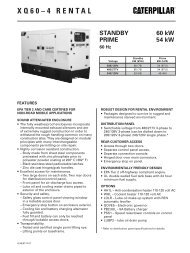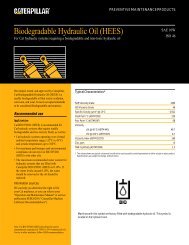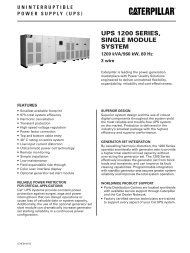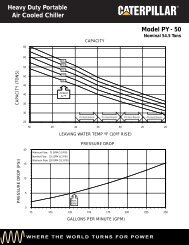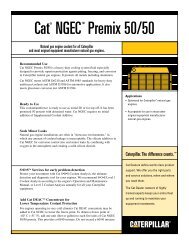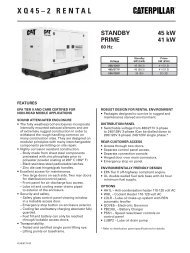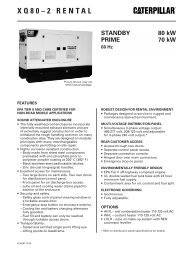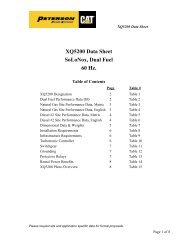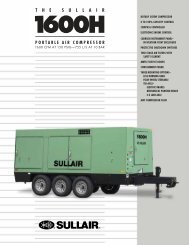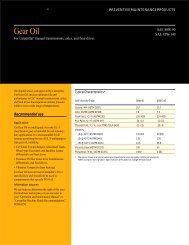Understanding SOS Service Tests - PEHP7076-02
Understanding SOS Service Tests - PEHP7076-02
Understanding SOS Service Tests - PEHP7076-02
- No tags were found...
Create successful ePaper yourself
Turn your PDF publications into a flip-book with our unique Google optimized e-Paper software.
MAINTENANCE SERVICES<strong>Understanding</strong> S·O·S SMYou’ll get greater benefits from your S·O·S <strong>Service</strong>sprogram when you understand the tests chosen byCaterpillar ® engineers to monitor oil condition andcontaminants.<strong>Service</strong>s <strong>Tests</strong>Know what the numbers mean andmaximize your investmentS·O·S <strong>Service</strong>s are valuable management tools that canmaximize equipment life and productivity, and minimizeoperating costs and downtime. Four types of analysis areperformed on engine, hydraulics and drivetrain oil.• Wear Rate monitors and tracks metal wear particles,contaminants and oil additive package elements• Oil Condition compares used oil to new oil to see ifit is providing adequate lubrication and protection• Oil Cleanliness determines if abrasive contaminantsare causing accelerated wear• Additional <strong>Tests</strong> detect water, glycol or fuel in oilTake oil samples at consistent intervals to detect potentialproblems early, reduce repair costs and lessen the impactof downtime.
S·O·S Wear Rate AnalysisPrevent problems and reducecosts by knowing wear ratesWear Rate Analysis is an integral partof our S·O·S <strong>Service</strong>s program that helpsyou maintain equipment performance andmaximize availability. Through regularlyscheduled testing of oil samples fromyour engine, hydraulics and powertrainsystems, Wear Rate Analysis detects tinymetal particles caused by componentwear. By monitoring trends in the typeand quantity of particles, you can getearly warning of problems before majordamage occurs.<strong>Understanding</strong> wear metalsEvery oil-washed system—engines,hydraulics, transmissions, and final drives—produces wear metals in everyday operation.If wear accelerates, the concentration ofwear metal particles increases, signaling aproblem. Wear Rate Analysis allows you tofind problems before they result in majorrepairs or machine failure.Wear Rate Analysis can detect particles thatrange up to about 10 microns in size. Wearmetal concentrations are expressed in partsper-million(or ppm). The S·O·S <strong>Service</strong>sprogram tests for at least nine differentsubstances: copper, iron, chromium, lead,tin, aluminum, molybdenum, silicon andsodium. All are wear metals found inCaterpillar machines and engines exceptsilicon (which generally indicates dirt) andsodium (which indicates water or coolant).Certain elements in a sample may be fromthe oil additive package rather than fromwear within the system. Skilled dealerinterpreters can tell the difference betweennormal elements and those that indicateabnormal wear.Trending wear metalsin your equipmentTwo identical machines under identicalconditions may generate wear particlesat different rates. Our S·O·S interpretershave access to a large database of samplesfor comparison with samples from yourequipment. However, your own machinesprovide the best guidelines for appropriatelevels of wear metals in each compartment.That’s why trending is an essential partof Wear Rate Analysis. After three sampleshave been taken from a particular compartment,a trend for each wear metal isestablished. Our interpreters then comparesubsequent samples to this trend lineto quickly spot deviations as well asmonitor gradual changes in concentrationlevels. This attention to trends also assistswith life cycle analysis, helping youoptimize productivity.The technology behindWear Rate AnalysisWe use an emission spectrometerto perform Wear Rate Analysis.The spectrometer determines wearelements and silicon in a sampleby subjecting the oil to very hightemperatures. At these temperatures,the elements in the sample are“atomized,” with each emitting adifferent wavelength of light energy.An optical system measures andrecords the light energy and calculatesthe results in parts-per-million foreach element.
MAINTENANCE SERVICESEngines–Top EndPrimary ElementCombinations of Classic Wear ElementsSecondary Element Potential Wear Probable Problem Area/CausesSilicon (dirt) Iron, Chrome, Aluminum Liners, Rings, Pistons Air Induction System/Filter Dirt ContaminationIron Chrome, Aluminum Liners, Rings, PistonsAbnormal Operating Temps., Oil Degradation,Fuel and/or Coolant Contamination, Stuck/Broken RingsChrome Molybdenum, Aluminum Rings, Pistons Blowby, Oil Consumption, Oil DegradationEngines–Bottom EndHydraulicsIronLiners, Gears,Valve Train, CrankshaftAbnormal Operating Temps., Lack of Lubrication,Contamination, Storage (Rust)Silicon (Dirt) Lead, Aluminum Bearings Dirt ContaminationLead Aluminum BearingsLack of Lubrication, Coolant Contamination,Fuel ContaminationSilicon (Dirt) Molybdenum, Aluminum Cylinders, Rods Dirt ContaminationCopper Iron Hydraulic Pumps Oil Degradation, ContaminationTransmissionsFinal DrivesIronAluminum, ChromeRoller or needlebearingsAluminum Iron, Copper Torque ConverterBearing fatigue/failureBearing wear/failureallowing contactSilicon (Dirt) Iron, Aluminum Gears Dirt Contamination, Clay Soils ContaminationIron Sodium, Chrome Gears, Bearings Water Entry, Preload LossPinpointing the causes andeffects of component wearBy comparing infrared (Oil Condition) test results with wear metalbuildup, we can pinpoint probable causes of elevated wear metals.The chart above illustrates some of the most common wear metals,their source(s), and the potential problems they indicate in oillubricatedsystems.Spectrometry detects dirt contamination, as well as wear metals.Silicon is the most common element indicating dirt entry, althoughsome clay soils also produce increased aluminum readings.Monitoring your componentsWhen S·O·S oil analysis identifies an increase in the concentration ofone or more metals, it can point to the wearing component most likelycausing the increase and, often, the probable cause. For example, asudden increase in copper and iron in a hydraulic oil sample wouldprobably indicate a problem with the hydraulic pump caused by eitheroil degradation or contamination (see chart, above).Silicon/aluminum ratio indirt varies by locationThe primary constituents of dirt areminerals containing silicon and aluminum.The ratio of these two elements varieswidely from place to place. Clay soilscontain nearly as much aluminum assilicon. This is one reason why localinterpretation of your sample results isimportant. We are familiar with the soilsin your area, giving us the best understandingof the combinations ofelements in your samples.
S·O·S Oil Condition AnalysisMaximize performance byknowing your oil conditionOxygen exposure, heat and contaminantscause all oils to degrade. Engine oil isparticularly susceptible to degradation bysulfur, nitration, by-products of combustion,high temperatures, and water from thecombustion process or condensation. OilCondition Analysis, part of the comprehensiveS·O·S <strong>Service</strong>s program, helps preventcomponent damage by monitoring your oiland keeping track of its degradation. OilCondition Analysis also allowsyou to correct problems that affect oilperformance. The bottom-line benefit:maximum oil performance, optimum oilchange intervals and reduced repair costs.<strong>Understanding</strong> OilCondition AnalysisOil Condition Analysis is similar to WearRate Analysis with one important exception:It evaluates chemical compounds in the oilrather than wear element particles.Oil Condition Analysis is important foroil from all systems: transmissions andhydraulics, as well as engines.It works like this:1 You submit a sample of new oil, called“reference oil,” when you enroll in theS·O·S <strong>Service</strong>s program and when youget new shipments of bulk oil. Referenceoil samples are processed at no cost toyou. If you are using Cat oil, new oilsamples may not be necessary. Adviseyour S·O·S analyst of the viscosity of theCat oil you use in each system; it has itsown Cat oil reference samples.2 The new oil is scanned by a specialinstrument using infrared light. Informationis stored in the instrument’s memory.3 At each scheduled interval, you submita sample of used oil.4 The Oil Condition Analysis instrumentfocuses a beam of light through a filmof used oil and records the data.5 The instrument uses a mathematicalformula to compare the used and newoils and quantify any differences.Fourier TransformInfrared AnalysisS·O·S Oil Condition Analysis includesan infrared instrument that uses amathematical method to convert rawinstrument data into meaningful terms.This test, often called FT-IR (FourierTransform Infrared Analysis), identifiesand quantifies organic compound groupsby measuring their infrared absorptionat the specific wavelength of each group.Besides identifying oxidation, soot, sulfurproducts and nitration, the test is alsoused to scan for oil contamination byfuel, water or glycol (engine coolant).
MAINTENANCE SERVICESIdentifying contaminantsbefore they cause problemsOil Condition Analysis detects soot, oxidation,nitration products and sulfur products/acids.This test can also detect contaminationby water, fuel and glycol from coolant. Ifdetected, specific contaminant tests are usedto confirm findings. Oil Condition Analysisfocuses on:SootSoot is found only in engine oil. It is theinsoluble residue of partially burned fuel.It is held in suspension by the oil additivepackage and causes engine oil to turn black.When soot drops out of suspension in theoil, it contributes to additive depletion andeventually increases oil viscosity. Heavyconcentrations of soot can cause bearingdamage by starving contact surfacesof lubrication.OxidationOxidation occurs in transmission, hydraulicand engine oils when oxygen moleculeschemically join with oil molecules.This chemical reaction is accelerated byhigh oil temperatures, glycol contaminationfrom engine coolant, the presence of copper,and from extended oil change intervals.Oxidation causes the oil to thicken, formacids, and lose lubrication qualities, whichthreatens the life of your components.Oxidized oil will cause deposits on enginepistons and valves, stuck rings, and borepolishing. In hydraulic systems andtransmissions, it can cause valve scuffingand sticking.Nitration ProductsNitration occurs in all engine oils, but isgenerally only a problem in natural gasengines. Nitrogen compounds from thecombustion process thicken the oil andreduce its lubricating ability. If nitrationcontinues unchecked, it can result in filterplugging, heavy piston deposits, lacqueringof valves and pistons, and eventual failure.Sulfur Products/AcidsSulfur is present in all fuels and affectsall engines. During combustion, fuel sulfuroxidizes, then combines with water toform acid. Acid corrodes all engine parts,but is most dangerous to valves and valveguides, piston rings and liners.Optimizing your equipmentwith the S·O·S <strong>Service</strong>s programOil degradation may be the result of anumber of factors and conditions, includingextended oil change intervals, abnormaltemperatures, or contamination by fuel,water or coolant. Lower quality oils willdegrade more rapidly than a premiumquality lubricant.With Oil Condition Analysis, you candetermine the extent to which oil hasdeteriorated during use and verify whetherit is performing up to specification duringthe entire oil change period. Oil ConditionAnalysis is just one part of the S·O·S <strong>Service</strong>sprogram that provides information toreduce downtime and save you moneyby preventing major equipment problems.Glycol, Water and Fuel DetectionFluid ContaminantsWhen present in your engine oil or fluidpower system, water, glycol (coolant) orfuel can indicate a number of problems,from incorrect engine timing (fuel) tocooling system leaks. By detecting theseproblems before they cause componentfailure, we can work with you to scheduledowntime and maximize productivity.Glycol (Coolant)Glycol causes rapid oxidation of the oiland usually indicates a cooling systemleak. Severely oxidized oil becomes stickyand forms sludge that plugs the filter. Anyamount of glycol contamination in the oilis unacceptable. Engines, hydraulics ortransmissions using water-to-oil coolersmay become contaminated with coolantif a leak develops in a cooler tube or seal.WaterIf infrared analysis indicates the presence ofwater, the approximate amount is determinedby placing a drop of oil on a plate heated tobetween 230˚ and 250˚ F. If water is presentthe oil will bubble and sputter. By comparingthe amount of bubbling to laboratorycontrol samples, experienced laboratorytechnicians can determine the quantity ofwater in the sample. Any amount over 0.5percent is considered excessive.Water can contaminate a system by leakingin from the outside or condensing in theengine’s crankcase or compartment. Whenwater combines with oil, it reduces the oil’sability to lubricate and forms a sludge thatplugs filters. Water passing between veryclose components can create “hot spots.”If the water gets hot enough, it causes tinysteam explosions that can fracture metal.FuelFuel contamination is confirmed using aflash test in which the used oil is heated toa prescribed temperature in a closed cup,then subjected to a flame. Fuel vaporsdriven off by the heat will flash if thedilution exceeds four percent.Fuel in the engine oil reduces its lubricatingproperties. Small amounts of fuel are commonas a result of the combustion process.But if fuel levels exceed recommendedlevels, we will suggest a check for defectivefuel injection nozzles and other sourcesof leakage. Fuel dilution is generally theresult of extended idling, incorrect timing,or a problem with the fuel injectors,pumps or lines.
S·O·S Oil Cleanliness AnalysisClean oil keeps equipmentrunning rightCounting the tiny particles in an oil sampleidentifies harmful contaminants that shortencomponent life. It can also pinpoint largerparticles that signal imminent equipmentfailure. Our S·O·S <strong>Service</strong>s programfinds these particles through a combinationof tests that includes Particle Count.Fighting an unseen enemyEven particles far too small to see can causedamage. In fact, oil that looks clean maycontain particles that cause abrasive wear.Particle contamination:• Accelerates component wear• Reduces system efficiency• Diminishes equipment performanceLearn About ISO Cleanliness CodesThe International Standards Organization(ISO) has developed a code system forconvenience in discussing the cleanlinesslevel of a fluid. The system reports onparticles at two important size catagories(>5 micron and >15 micron). You may wishto learn more about this system of reportingoil cleanliness to better manage the lifeof your hydraulic and transmissioncomponents. If you are interested askus for Form No. PEJT5<strong>02</strong>5 ReportingParticle Count by ISO Code.The technology behindParticle CountS·O·S labs use a technique calledlight extinction to “count” theparticles. The sample is passedthrough a beam from a speciallight source. When a particle inthe oil passes through the beam,a sensor monitors changes in thelight, counts the particles andrecords their sizes. This testdetects particle contaminantsthat can lead to acceleratedwear and other costly problems.Going beyond WearRate AnalysisParticle Count, which is used fortransmission and hydraulic system oilsamples, is one of two tests in the S·O·S<strong>Service</strong>s program that look at particles.The other is Wear Rate Analysis, whichuses spectrometry to identify metal particlesfrom 8 to 10 microns in size. UnlikeWear Rate Analysis, Particle Count detectsmetallic and non-metallic particles from2 to 100 microns. However, ParticleCount only reports the size and numberof particles, not their composition.Particle Count is the most efficient wayto identify non-metallic particles in oil.These may include silicon from dirt orsynthetic friction materials that signaldeterioration in transmissions, steeringclutches and brakes. Gasket, seal, filterand hose material can also be detected.Another benefit of Particle Count is itsability to detect particles larger than 10microns that cannot be seen by WearRate Analysis or any other oil analysistest. These larger particles are a signof imminent failure if the problem isnot corrected.Particle Count is only used for non-engineoil samples because engine oil contains sootthat cannot be distinguished from metalparticles or debris.
Count on our experts.The S·O·S <strong>Service</strong>s program is just one ofmany maintenance products andservices we offer to help youmaximize productivity and reduceoperating costs. For example, you maywish to check into our maintenancesoftware programs. Trend AnalysisModule (TAM) permits you to receiveyour S·O·S results electronically.Maintenance Control System (MCS)is a Windows ® -based system formaintenance and repair scheduling.Preventive Maintenance Planner (PMP)provides convenient checklists formaintenance personnel at each serviceinterval. Talk to our experts or stop infor a demonstration.<strong>PEHP7076</strong>-<strong>02</strong> For more information, see us today Printed in U.S.A.or visit our Web site at www.CAT.com© 2000 Caterpillar




